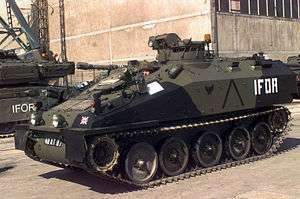FV103 Spartan
| FV103 Spartan | |
|---|---|
 | |
| Type | Armoured personnel carrier |
| Place of origin | United Kingdom |
| Specifications | |
| Weight | 10,670 kilograms (23,520 lb) 9 ton 55 lbs Battle weight |
| Length | 5.16 metres (16.9 ft) |
| Width | 2.48 metres (8 ft 2 in) |
| Height | 2.63 metres (8 ft 8 in) |
| Crew | 3, with 4 passengers |
|
| |
Main armament | 1 x 7.62 mm GPMG |
| Engine |
Jaguar J60 4.2 litre DOHC inline six petrol 252 lbs/ft @ 3000rpm |
| Power/weight | 17.9 hp/t |
| Suspension | Torsion bar |
Operational range | 510 kilometres (320 mi) |
| Speed | 96 kilometres per hour (60 mph) |
FV103 Spartan is a tracked armoured personnel carrier of the British Army. It was developed as the APC variant of the Combat Vehicle Reconnaissance (Tracked) family. The vehicle can carry up to seven personnel, including three crew members. Armed with a single machine gun, it is almost indistinguishable from the FV102 Striker in external appearance. Rather than a general personnel carrier for infantry, the Spartan has been used for moving specialist teams, such as anti-aircraft missile teams. An anti-tank variant of the Spartan has been produced, named FV120 Spartan MCT; this is armed with MILAN anti-tank missiles. Nearly 500 Spartans have served with the British armed forces since entering service in 1978; they are now being replaced by newer vehicles.
Design and features
The FV103 Spartan was developed during the 1970s as the Armoured Personnel Carrier (APC) version of the British Army's Combat Vehicle Reconnaissance (Tracked) (CVR(T)) family of armoured fighting vehicles, designed by Alvis plc.[1] The vehicle entered service with the British military in 1978.[2] The Spartan is similar in appearance to the FV102 Striker, except for the missile launcher on the Striker.[3]
The Spartan was powered by a 4.2 xk jaguar petrol engine. The vehicle is 5.16 metres (16.9 ft) in length and 2.48 metres (8 ft 2 in) in width. With a ground clearance of 0.33 metres (1 ft 1 in), it has a height of 2.63 metres (8 ft 8 in).[4] As the APC variant of the CVR(T) family, the FV103 has been used by small specialized groups such as mortar fire controller teams, anti aircraft teams and also reconnaissance teams.[4][5] The vehicle can carry seven personnel, in a combination of three crew members and four passengers or two crew members and five passengers.[6] It is armed with one 7.62 mm L37A1 machine gun, and can have four smoke dischargers on each side. In addition to the APC role, it has also been used as a resupply vehicle for the FV102 Striker, carrying extra Swingfire missiles.[2] The FV103 has combat weight of 10,670 kilograms (23,520 lb). It can achieve a maximum speed of 96 kilometres per hour (60 mph) and has a range of 510 kilometres (320 mi).[4] It is capable of negotiating up to 60% gradients.[2]
Variants and service
An anti-tank variant of the FV103 was produced; this was named the FV120 Spartan MCT (Spartan with MILAN Compact Turret). The FV120 has a two-man turret, and is equipped with two MILAN Anti-Tank Light Infantry Missiles in launch positions, while 11 more can be carried internally.[6]
A 'stretched Spartan' design was considered as a future replacement for the FV430, adapted by adding an extra road wheel enabled allowed 3 more dismounted personnel (7+3 crew), and replacing the Jaguar petrol engine with a Perkins diesel offered greater range.[7] CVR(T) prototype number 11 (a Scorpion) was cut and extended to demonstrate the basic hull could be used as a ten-man Armoured Personnel Carrier (APC), and a diesel engine fitted. When tests confirmed the stretched version retained the mobility of the basic CVR(T) MVEE then built another prototype from scratch with a wider hull[8] called the FV4333, later renamed Alvis Stormer (Alvis having purchased the design rights). The Alvis Stormer and subsequent developments are described in a separate article.
In 2006 it was reported to the House of Commons that 478 FV103 vehicles were in service with the armed forces of the United Kingdom in April of that year, 452 of them in deployable state.[9] By 2007, 495 FV103 Spartans were in the service of the United Kingdom.[10] However, these were being replaced by mid-2009 with Panther Command and Liaison Vehicles.[11]
Belgium began using Spartans, along with other CVR(T) vehicles, in their cavalry units from 1975.[12]
Operators

Current operators
-
.svg.png) Belgium
Belgium -
 Botswana
Botswana -
 Iraq 100 vehicles
Iraq 100 vehicles -
 Jordan
Jordan -
 Nigeria Unknown number of vehicles
Nigeria Unknown number of vehicles -
 Oman
Oman -
 United Kingdom Army and R.A.F
United Kingdom Army and R.A.F
References
- ↑ Miller, David (2000). The illustrated directory of tanks of the world. Zenith Imprint. p. 381. ISBN 978-0-7603-0892-9.
- 1 2 3 Chant, Christopher (1987). A compendium of armaments and military hardware. Routledge. p. 63. ISBN 978-0-7102-0720-3.
- ↑ "Spartan". FAS Military Analysis Network. Retrieved 20 March 2010.
- 1 2 3 "Spartan and Other CVR(T) Vehicles". British Army. Retrieved 20 March 2010.
- ↑ "Spartan". Global Security. Retrieved 20 March 2010.
- 1 2 Rinaldi, Richard A. "Modern British Army Equipment" (PDF). Orders of Battle. Retrieved 20 March 2010.
- ↑ "CVR(T)". Global Security. Retrieved 20 March 2016.
- ↑ Foss, Christopher. Jane's Armour and Artillery 1981-82. Jane's Publishing Co Ltd. ISBN 9780531039762.
- ↑ "House of Commons Hansard Written Answers for 04 July 2006". United Kingdom Parliament. 4 July 2006. Retrieved 20 March 2010.
- ↑ "United Kingdom: Strategic Export Controls Annual Report 2007" (PDF). British Foreign and Commonwealth Office. July 2008. p. 95. Retrieved 20 March 2010.
- ↑ "Panther". Ministry of Defence (United Kingdom). Retrieved 20 March 2010.
- ↑ "Historique du Premier Régiment de Lanciers" (in French). Belgian Army. Retrieved 20 March 2010.
Further reading
| Wikimedia Commons has media related to FV103 Spartan. |
- Howard, Les. Winter Warriors - Across Bosnia with the PBI 1995/1996. The Book Guild, 2006, ISBN 1-84624-077-8